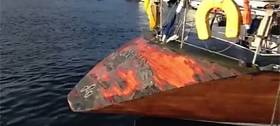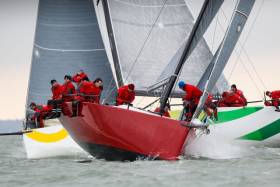Displaying items by tag: Royal Cork Yacht Club
Queen of Irish Yachting Moonduster is 'Sad Sight' in Norway
There has been plenty of comment on social media about the current condition of the much loved Irish yacht Moonduster, the former Round Ireland record holder skippered by the late Denis Doyle of the Royal Cork Yacht Club. See the full video below.
'Sad to see this. Many happy hours on that beautiful vessel in and out of Cork Harbour', says Stu McLoughlin echoing many similar comments about the state of the one time pristine Frers 51 that was the pride of the Irish fleet in the 1980s.
Sad to see Moonduster looking like this!
Posted by SailCork.com on Saturday, 27 February 2016
Doyle owned four different Moondusters in his long career. His last boat, arguably the best known, the varnished Frers, was sold to Norway around 2005 where she is still sailing but as can be seen in the photographs not in the same state of repair as she had been in Crosshaven.
'...She's in a shocking state, clearly her current and previous owners never cared too much about her. However, she's still salvageable but for how much longer? says Mark Richards on Facebook.
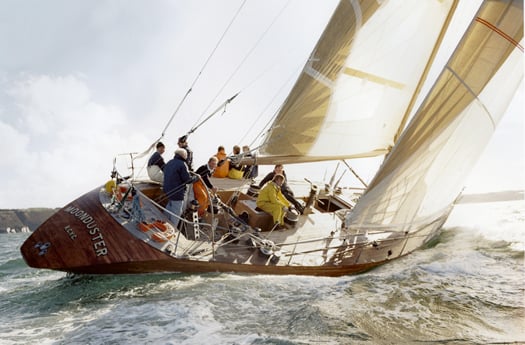
The queen of all fleets. Denis Doyle's legendary Moonduster was the flagship of Irish offshore racing for twenty years. Readers will recall Bob Bateman's 1988 classic photograph of Doyle at the helm. Doyle's enthusiastic support moved the Round Ireland Race into the international league, and his regular participation set performance standards which greatly enhanced the event.
Ted Crosbie on a Lifetime in Sailing
Sailing is, definitely, a ‘sport for life’ but “you have to find a bit of time for it and, if you have a family, don’t let it hog your whole life and try to take your family with you.”
Good advice that from one of Cork’s sailing icons, Ted Crosbie, one of the leading figures also in the Irish newspaper industry for many years through ‘The Cork – and currently Irish – Examiner and Evening Echo.’
Despite being a leading national newspaper owner for a long time, Ted has never sought personal publicity. So when I got the opportunity to interview him for my Podcast on Afloat, I was delighted to get his views on sailing which you can listen to here. Ted started sailing at the age of 10.
• Read also Ted Crosbie in the Spring edition of Afloat Magazine in shops next week.
Tom's Crosbie's boat 'No Excuses' is for sale here
RORC Easter Challenge Starts the Season on the Solent
The Royal Ocean Racing Club's UK domestic season fires up with the Easter Challenge, taking place on the Solent over the Bank Holiday weekend of 25-27th March. Last year, Anthony O'Leary's Royal Cork crew won the Spring event overall and this year the event is an important build–up to the Commodore's Cup in July. The Irish Cruiser Racer Association (ICRA) is reported to be considering sending two teams to defend the international title so a strong Irish entry in Cowes might be expected next month.
For many crews, the Easter Challenge marks a key date in their diary, by which their boat must be recommissioned and back in the water ready for the new sailing season. To help crews get up to speed again as quickly as possible, particularly those looking to enter this year's Brewin Dolphin Commodores' Cup, the RORC has set up the Easter Challenge as a start of season training regatta.
The RORC ropes in some of the world's best to carry out this tuition. The coaching team will once again be led by Jim Saltonstall, MBE. Saltonstall has played a pivotal role in the success of most of Britain's leading Olympic sailors including Sir Ben Ainslie, Chris Draper, Iain Percy, Nick Rogers and the RORC's own Principle Race Officer, Stuart Childerley.
He will be supported by the RORC's CEO Eddie Warden Owen, himself a former America's Cup coach with Team New Zealand and latterly with the Spanish Desafio Espanol team in Valencia in 2007.
Once again integral to the coaching will be North U. Regatta Services, with specialists Chuck Allen and Andreas Josenhans flying across to the UK especially for the regatta. Both are well known sailors and highly experienced coaches and sailing performance analysts in the USA.
Inshore racing at the Easter Challenge is scheduled to run from the Friday morning (25th March) until Easter Sunday early afternoon, allowing teams to get home for the evening, laden with the chocolate prizes they will have won. -- James Boyd
National 18s to Vote on Class Changes at EGM in Royal Cork
The National 18 dinghy class will hold an extraordinary general meeting on Saturday, 27th February at Royal Cork Yacht Club to vote on three new proposals for the three man centreboarder.
The first proposal seeks approval to allow Morrison division National 18’s to carry mainsail aligned to modern design and construction materials. The new mainsail can be made in either Dacron or HMPE/aramid fibre laminate.
Full details of the egm are carried in a notice downloadable below.
Ireland’s Boats & People – How Do We Get Them Together?
The recently-published ISA Survey of Club Racing commissioned and supervised by Board Member Jack Roy has started the process of putting together a realistic picture of how we sail and go afloat for recreation, and it was analysed on publication here in Afloat.ie.
It’s logical to have made the beginning with club racing, as racing provides its own narrative and a straightforward set of entry numbers and results. But it will become more complex as the national authority tries to provide realistic figures for day sailing’s less competitive aspects. And of course, once we enter the world of cruising as defined by sailing and boating projects which include passage making, both coastal and offshore, together with overnight on-board stops, then it can become much more difficult to get meaningful data.
Yet with the ISA’s Cruising Conference for February 20th already booked out within a few days of being announced on Afloat.ie, clearly that is an area in search of services and support, a section of sailing which is difficult to quantify yet obviously of strong interest to a significant number of boat enthusiasts. W M Nixon takes a look at how the complexity of our sport’s many specialities makes it difficult to provide a clearcut picture for possible recruits to sailing.
Where would we be without the International Optimist Dinghy? The little solo-sailing boxes and their attendant support teams of mum and dad and the dog and the old 4X4 or station wagon or people carrier or whatever may seem to take up an awful lot of space and time, and all just so that one little person can go sailing.
But at least that one little person does go sailing. The ISA figures are brutally straightforward. In terms of genuine turnouts afloat at clubs throughout Ireland, in boat numbers the active Optimists are exceeded only by the Lasers, and this is arguably because Lasers aren’t age-limited, whereas the Optimists most definitely are.

Optimist airborne. This is Ireland's second most popular class
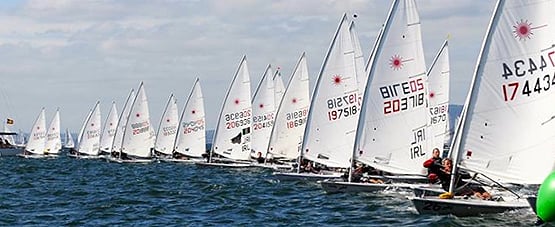
Ireland’s most popular dinghy class, the Laser is seen here at the Zhik Irish Nationals at Ballyholme
So we give a qualified cheer for the success of these two little boats. But it’s qualified because they’re single-handers which fail to provide any crew-relating sailing skills. Leading sailing figures as diverse as Des McWilliam of Crosshaven and Norman Lee of Greystones have been eloquent in promoting the notion that we should be doing more – much more – to encourage two-handed boats, and if we can persuade people into three-handed boats, well, so much the better.
Certainly that’s one of the reasons why our header photo says so much. A lone sailor in an Optimist or Laser promotes too much of a solitary, even an isolated image. And a two-handed boat like the GP 14, whose strong fleet figures in the ISA survey show the class’s vigour, is arguably just an act for a dynamic duo – it’s Strictly Come Dancing goes sailing…..
But getting three together to race a characterful boat like the National 18 with style – now that’s something special, that really is a superb combination of people skills interacting with sailing talent. And it’s a joy to behold. Yet anyone can see that for a complete beginner to sailing, this extraordinary silhouette of Tommy Dwyer’s National 18 against the November sky above the Hill of Howth will have an otherworldly air about it – “That’s not for me” is as likely a response as “Let’s have a go at that”.
Even those of us who have been in sailing for longer than we care to remember find the image decidedly thought-provoking, for we have some idea of what has been involved in creating the circumstances for this seemingly effortless balancing act, this lighter-than-air effect in the unlikely setting of a November afternoon.
Over the past year or so we have been recounting in Afloat,ie how the Cork Harbour National 18 Class, with very tangible backing from the Royal Cork Yacht Club, have been in the forefront of the development of the new ground-breaking Phil Morrison take on the long-established National 18, which is a developmental class which from time to time takes a leap in hull design, and moves forward in order to keep the spirit alive.
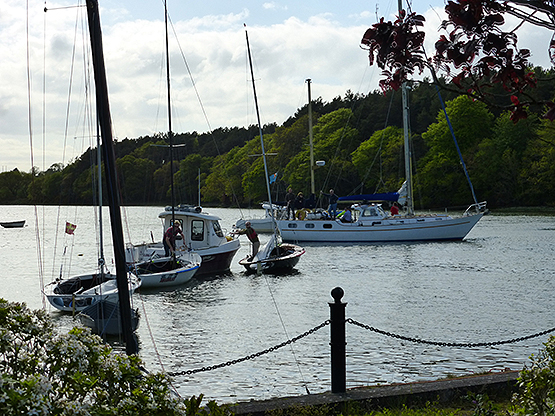
The National 18s are part of the fabric of Cork Harbour sailing. Before the new Morrison boats arrived in July, the old fleet were seen here in May 2015 after their annual race to Ballinacurra in northeast Cork Harbour in company with the Dwyer brothers’ cruising ketch. Photo: W M Nixon
Acceptance of this is something which seems to be bred into Cork’s National 18 enthusiasts, many of whom have the advantage of being firmly of the opinion that a proper dinghy needs three people to sail it. But the social matrix which has built up around Cork Harbour over many decades with this concept at its heart is not something which will necessarily travel easily to other areas, and although the six boats of the National 18 flotilla which visited Howth for the Open Day got a great reception and gave many people from other classes a marvellous time afloat, it’s probable that the very different mood around sailing in Dublin means that something so technically and socially challenging as a three man dinghy is a step too far.
Sailing in the greater Dublin area seems to exist within a framework of independent balloons. While there are those who will happily move from one boat type to another and cheerfully spread their talents and enjoyment about, by contrast there’s the Dublin Bay Sailing Club Thursday Evening Phenomenon.
Thursday is when the DBSC cruiser classes go out to race. And there’s an entire cohort of people, mostly folk who work in offices in the city, who on a Thursday evening go straight to Dun Laoghaire, get aboard a pontoon-based cruiser owned by someone else, go out and race in some very specific crewing job, then come back in and have supper in club or pub with their shipmates, and then that’s it until next Thursday. Just one evening each summer mid-week is their entire sailing programme. Weekends are for something else. And as for the hassle and mixed joys of boat ownership and maintenance, that’s not their department at all.
It’s a very metropolitan, very citified yet specialized way of doing things, and Dublin is one of the very few cities whose location facilitates it. It will be fascinating to measure it, for Dublin’s way of sailing is steeped in history and tradition. But for now it’s refreshing to look at a place which has had a sailing tradition in times past, but somehow lost it, yet it’s coming back again, and one of the good news stories towards the end of 2015 is that the new Youghal Sailing Club has been accepted into the ISA fold.
Youghal at present is a difficult place for sailing, as the tidal power of the mighty Munster Blackwater sweeps straight through the estuary and along the old town’s waterfront, and the creation of any meaningful modern facilities will have the immediate difficulty of silting by incredibly adhesive black mud.

With the sun out, and the tide in, Youghal looks to be an ideal location for the easy installation of a marina….....Photo: W M Nixon
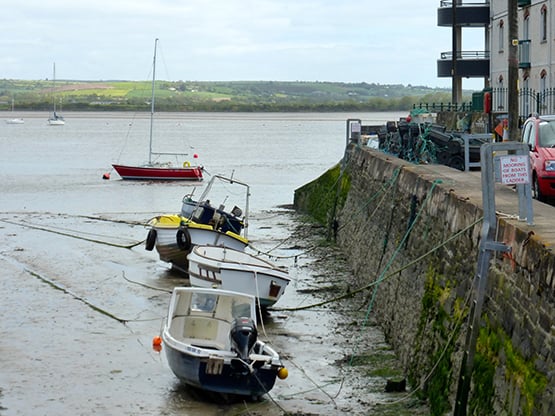
….but with the sun in and the tide out, the mud problem is revealed. Photo: W M Nixon
Thus, as dedicated Afloat.ie readers will have recently observed, no sooner had one group announced that a marina in Youghal was on the way than another longer-established group quietly suppressed the story, as they’re well aware of the engineering and dredging difficulties involved, and premature announcements will only slow any project in the long run.
In the fullness of time, a marina at Youghal will be a godsend for any cruiser plugging along the south coast. It’s not always the easiest coast in the world to make a passage along, sometimes it can seem an awfully long way to Cork from Dunmore East or Kilmore Quay even if you do make stopovers at Dungarvan or Helvick, and there are times when the hardiest seafarer is glad enough to get his boat secured to a good big pontoon.
But that’s for the future. Meantime, the locally-based keelboats are using either the restless anchorage off the town, or the more serene pool across the estuary at Ferry Point on the east shore, while the new club’s flotilla of GP 14s are stored in spare warehouse space during non-sailing time, and when they do go sailing it turns out their clubhouse is a moveable feast - it’s a caravan which can be towed to a choice of sailing locations.
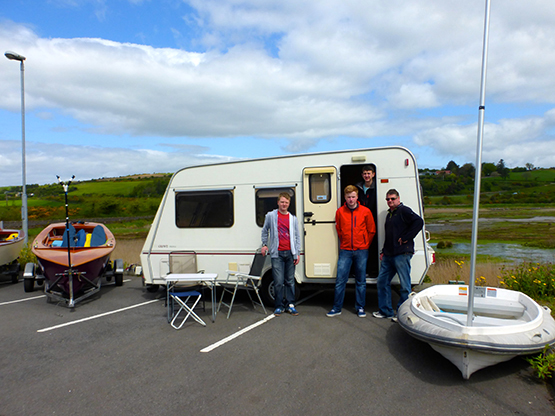
A moveable feast. Members of the newly-affiliated Youghal Sailing Club with their caravan HQ, Adrian Lee in doorway. Photo: W M Nixon
On the national stage, it is young Youghal GP 14 sailor Adrian Lee who has been among those flying the club’s flag, and there’s hope in the air. When we were there in May on a fine day that promised a summer which never arrived, we couldn’t help but think that when they do get their facilities and maybe even a clubhouse, they’ll look back to the days of the caravan and ad hoc racing arrangements with sweet nostalgia. For sometimes, it’s much better to be travelling than it is to arrive.
But for the rest of us, the message from Youghal is simple. The sea is for sailing. Use it or lose it. By all means get proper people surveys done which indicate the way numbers are shaping up and things are going. But really, if you want to persuade people to go sailing, the best way is by example, getting afloat as much as possible yourself. And maybe then you’ll find the time to welcome aboard newcomers too.

Reviving Youghal sailing – on race days, the club’s caravan is simply towed down to the pier and the races are started from there. Photo: W M Nixon
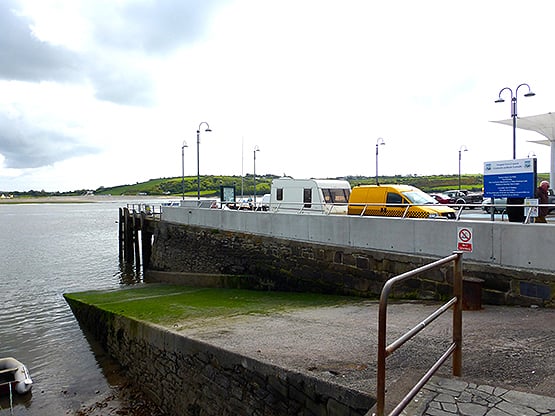
Youghal’s massive public slip provides launching for the YSC sailing dinghies, but during 2015 the boats had to be stored at the other end of town when not in use. Photo: W M Nixon
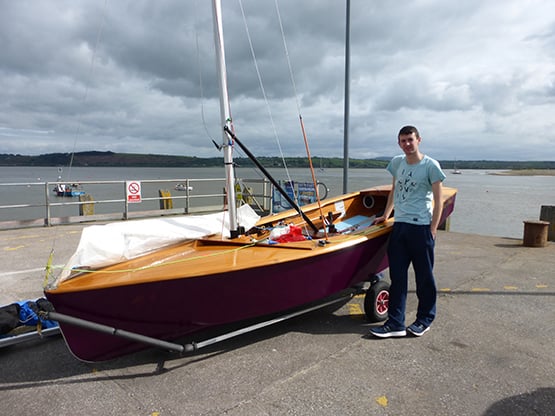
The pace-setter. Adrian Lee of Youghal SC with his Duffin-built GP14. Photo: W M Nixon
Click to download: ISA Survey of Club Racing
Cork Week Announces 'Beaufort Cup' for International Services Teams
The inaugural Beaufort Cup will take place this July hosted by the Royal Cork Yacht Club, Crosshaven, Co Cork, Ireland, as part of the highly successful Volvo Cork Week. It will be part of a series of Irish Government supported National, and International commemorations in 2016, to recognise the significant events that took place a century ago, leading to the creation of an Independent Irish Republic.
The Royal Cork Yacht Club, supported by the Irish Defence Forces is inviting services from Ireland, Europe, and further afield, to compete for the Trophy. It is hoped that Defence Force Teams from a number of countries will compete and also other services such as Police, Fire, Rescue, RNLI and Coastguard service teams.
“The Beaufort Cup invites sailing teams from their associated national services, 50% of each team must be active in the service they represent. Racing will take place over five days in a mix of challenging offshore and tactical inshore racing. Teams will get the chance to enjoy the renowned social experience of Volvo Cork Week and the winning team will also have €10,000 donated to a nominated charity of their choice while the winner will also be eligible for the ‘Boat of the Week’ prize at Volvo Cork Week 2016” says Kieran O’Connell, Chairman of Volvo Cork Week.
'It is with huge excitement that we announce the inaugural Beaufort Cup which is going to be part of Volvo Cork Week 2016. This event will attract teams from many countries and will add a unique and exciting element to the already fun packed Volvo Cork Week 2016', O'Connell say.
This event hopes to develop valuable bonds between national team members and international colleagues alike, through a competitive, but also very sociable, event. The Beaufort Cup represents a fantastic opportunity to strengthen international ties through offshore sailing and closely fought inshore racing in the natural maritime amphitheatre that is Cork Harbour.
The inaugural event, hosted by the Royal Cork Yacht Club, will truly be a historic occasion and the Irish Defence Forces are delighted to have the opportunity to support, and compete, in the Beaufort Cup. The Irish Naval Service Headquarters is located in the heart of Cork Harbour and will play a strong supportive role in the event.
The Oldest Yacht Club in the World & The Membership Issue
My Podcast about membership of sailing and yacht clubs - GETTING MEMBERS IN – INSTEAD OF KEEPING PEOPLE OUT - drew a lot of attention and comment…. It seems to have touched a topic that quite a few people felt should be openly discussed……so it is appropriate that the oldest yacht club in the world, heading for its Tercentenary – 300 years in existence – considered the issue at its annual general meeting this week.
The out-going Admiral of the RCYC – the Royal Cork Yacht Club in Crosshaven - Pat Lyons, got directly to the centrality of the issue which is a problem for many clubs in sailing, though also not a problem exclusive to maritime sport.
While the club continues to attract new members, there is an on-going erosion of its long–term membership base, he said.
So, having congratulated the new RCYC Admiral, John Roche, on his appointment, I asked him if the club was any different from others around the country, facing membership problems. He takes over leadership of the RCYC for the next two years and told me that it was no different from any others in having to address issues of membership, with an ageing scenario also. A range of initiatives is being devised as a long-term strategy.
“These will benefit the club over time, placing our focus on remaining aware of and responding to, the evolving needs of the sailing community.”
Former Cork Port Harbour Master, Pat Farnan, was elected RCYC Vice-Admiral which places him in position to succeed to the office of Admiral in two years’ time.
Kieran O’Connell, who was re-elected as Rear Admiral Keel Boats at the RCYC agm, a tribute to his commitment and ability in running cruiser racing, is also Chairman of Cork Week.
John O’Connor is the club’s new Vice Admiral for non-racing cruising boats and Stephen O’Shaughnessy was elected to the role for dinghies.
Listen to the Podcast to hear the response of the oldest yacht club in the world to the membership issue and also about its plans for the Tercentenary in 2020 which are already being worked upon and the new competitions which will form part of this year’s Cork Week.
New Admiral Elected to Royal Cork Yacht Club
The 295th Annual General Meeting of the Royal Cork Yacht Club was held last night at its Crosshaven clubhouse electing a new Club Admiral as part of the formalities writes Claire Bateman.
The cordial meeting enjoyed a full house with some good participation from members.
The Executive had completed a two year term of office and former Admiral Pat Lyons conducted the business of the meeting until it was time for the election of officers.
Vice Admiral, John Roche, was duly elected as the new Admiral of the Royal Cork Yacht Club. The election of the Officers of the Executive Committee followed. It was then time to elect two members to the Finance and Administration Committee. Two members to the Bar, Catering and House Committee and two members to the Consultancy and Advisory Committee.
The discussion of General Business then followed and there being no further questions Admiral Roche declared the meeting closed and invited all present to join him for refreshments.
Blue Skies for Royal Cork's Winter League
Blue Skies and bright sun were were welcome visitors for the second day of racing at the O’Leary Insurance Winter League writes Claire Bateman.
A sizeable fleet of twenty boats arrived on the start line this morning ready and eager for an enjoyable day of racing having had two days already blown out by the extreme weather conditions.
Race Officers Clem and Wendy McElligott in Adrielle set up a line using the Cage as the pin end and as it was a mainly northerly breeze Clem had mentioned to your scribe beforehand that racing would be mainly up and down the harbour. Wendy has taken on the onerous task of chairing a results committee and as she told me herself she enjoys this type of activity so the Keelboat Committee are indeed fortunate to have this team on board and no doubt the hard worked Rear Admiral Keelbaats, Kieran O’Connell, will be very glad to have their experience and assistance in this very important area.
The fleet set of with a reaching start, some heading inshore to avoid the flood tide, while others did the opposite and stayed out in the tide hoisting spinnakers immediately before heading out the harbour for the No. 3 buoy. They then had a beat back in the harbour up to Cobh for another reach and run and finishing with a run out to No. 5 and a reach in to finish off the Cage. Beautiful though the weather looked it was still extremely cold as had been forecast and the sailors were glad to reach the warmth of the clubhouse.
On Monday night last a Members Forum had been held and the first bit of good news the Admiral had to impart was that the EPA had approved the plan for dredging of the marina area. This in fact has started at the Western end. The Executive Officers each spoke in their turn and highlighted what had been accomplished during the past year and the early plans for our tri centenary year celebrations in 2020. The forum proper was then opened to the floor and evoked some lively discussion from the small number in attendance. This was following on from a Junior Laying Up Supper on Friday night that had packed out the house. This fact led to discussion on the lack of young people participating in club activities and one statement was heard to come from the rear that each person in this room was old!!!. This was disputed in particular by some of the younger males in the attendance who informed the comment maker they were in fact younger than him and one attractive young bride of some few weeks stood up and performed a pirouette to show her agility. There was no mention of the fact that the rest of us who know we are ‘old’ still manage to turn out in all weathers to show our interest in our club and despite the fact there was a crucial soccer match on that evening the club took preference with us.
Ah well, we all have our views, and one thing for sure is that each member of the club both young and old will be putting their best foot forward to have an almighty event in 2020 that the Royal Cork Yacht Club will long be remembered for.
New 'IRC European Championships' To Be Staged At Cork Week
The first ever IRC European Championship will take place during Volvo Cork Week, 10-15th July 2016, Royal Cork Yacht Club has announced.
The new event in the RORC Calendar will be hosted by the Crosshaven club, in the sailing grounds of Cork Harbour and the Atlantic Approaches.
The first edition of the RORC IRC National Championship took place in 2000, and has done so every year since. There are now seven IRC National Championships throughout the world, but up until now, there has been no continental event.
"When the Royal Ocean Racing Club was approached by the Royal Cork Yacht Club to host the first IRC European Championship, our response was positive and immediate. We are now working together to finalise the details”, commented Michael Boyd, Commodore of the Royal Ocean Racing Club. “The IRC European Championship will be an event in itself, based on the platform of Volvo Cork Week, which is a long-established and well-organised IRC regatta. The timing of the IRC European Championship, in the middle of July, works well in relation to the RORC IRC National Championship in the Solent in June and as a precursor to the Brewin Dolphin Commodore's Cup between 23-30 July. The intention is for the IRC European Championship to be held at a different European location annually.”
"Royal Cork Yacht Club is honoured to be chosen to host the prestigious Royal Ocean Racing Club's inaugural IRC European Championships, during Volvo Cork Week 2016. This is a great honour for Irish sailing, and the fact that Ireland has been selected as the host nation for the first ever IRC European Championship, will guarantee support from IRC boats from all over Ireland as well as overseas.” commented Kieran O Connell, Chairman of Volvo Cork Week. “It is also a great reflection on the Race Management here at Volvo Cork Week, and shows the confidence that RORC have in The Royal Cork Yacht Club’s ability to manage an event of this scale. On the racing front, Volvo Cork Week 2016 will not disappoint, with plans already well underway to host a championship that will both meet and surpass the requirements of this unique world class event both on and off the water. We welcome all in advance”.


























